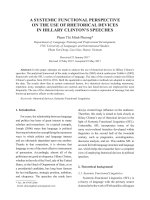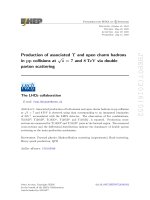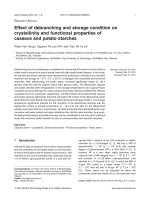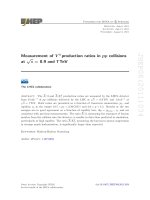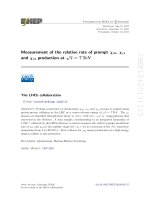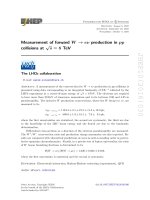DSpace at VNU: Production of functional dendritic cells from menstrual blood-a new dendritic cell source for immune therapy
Bạn đang xem bản rút gọn của tài liệu. Xem và tải ngay bản đầy đủ của tài liệu tại đây (544.42 KB, 8 trang )
In Vitro Cell.Dev.Biol.—Animal (2011) 47:368–375
DOI 10.1007/s11626-011-9399-2
Production of functional dendritic cells from menstrual
blood—a new dendritic cell source for immune therapy
Pham Van Phuc & Dang Hoang Lam & Vu Bich Ngoc &
Duong Thi Thu & Nguyen Thi Minh Nguyet &
Phan Kim Ngoc
Received: 21 December 2010 / Accepted: 22 February 2011 / Published online: 18 March 2011 / Editor: Tetsuji Okamoto
# The Society for In Vitro Biology 2011
Abstract Dendritic cells (DCs) are the most professional
antigen-presenting cells of the mammalian immune system.
They are able to phagocytize, process antigen materials,
and then present them to the surface of other cells including
T lymphocytes in the immune system. These capabilities
make DC therapy become a novel and promising immunetherapeutic approach for cancer treatment as well as for
cancer vaccination. Many trials of DC therapy to treat
cancers have been performed and have shown their
application value. They involve harvesting monocytes or
hematopoietic stem cells from a patient and processing
them in the laboratory to produce DCs and then reintroduced into a patient in order to activate the immune system.
DCs were successfully produced from peripheral, umbilical
cord blood-derived monocytes or hematopoietic stem cells.
In this research, we produced DCs from human menstrual
blood-derived monocytes. Briefly, monocytes were isolated
by FACS based on FSC vs. SSC plot from lysed menstrual
blood. Obtained monocytes were induced into DCs by a
two-step protocol. In the first step, monocytes were
incubated in RPMI medium supplemented with 2% FBS,
GM-CSF, and IL-4, followed by incubation in RPMI
medium supplemented with α-TNF in the second step.
Our data showed that induced monocytes had typical
morphology of DCs, expressed HLA-DR, HLA-ABC,
CD80 and CD86 markers, exhibited uptake of dextranFITC, stimulated allogenic T cell proliferation, and released
IL-12. These results demonstrated that menstrual blood can
P. V. Phuc (*) : D. H. Lam : V. B. Ngoc : D. T. Thu :
N. T. M. Nguyet : P. K. Ngoc
Laboratory of Stem cell Research and Application, University of Science,
Vietnam National University,
Ho Chi Minh, Vietnam
e-mail:
not only be a source of stromal stem cell but also DCs,
which are a potential candidate for immune therapy.
Keywords Dendritic cells . Menstrual blood . Immune
therapy . Dextran-FITC uptake . IL-12 production . T cell
stimulation
Introduction
Dendritic cells (DCs) were firstly discovered by Steinman
and Cohn (1973). Until now, many studies had been
performed to identify the origin, phenotypes, and functions
of DCs as well as their subtypes. DCs are one of antigenpresenting cells. They act as messengers between the innate
and adaptive immunity.
In the body, DCs originated from hematopoietic bone
marrow progenitor cells. In the differentiation process,
these progenitor cells initially transform into immature
dendritic cells (imDCs). These cells are characterized by
high endocytic activity and low T-cell activation. They can
engulf viruses and bacteria in the surrounding environment
through pattern recognition receptors and toll-like receptors
(TLRs) are one of them. ImDCs probably also originated from
monocytes, a type of leukocytes which circulate throughout
the human body. When recognizing the suitable signals,
monocytes will turn into either DCs or macrophages.
In vitro DCs can be successfully generated from
monocytes or CD34-positive hematopoietic stem cells
(HSCs) from bone marrow, peripheral blood, and umbilical
cord blood (Reid et al. 1990; 1992; Caux et al. 1992;
Bender et al. 1996; Romani et al. 1996; Rosenzwajg et al.
1996; Strunk et al. 1996; Morse et al. 1997; Lutz et al.
1999; Thurner et al. 1999; Kyung et al. 2004). A widely
used procedure is to induce monocytes or HSCs into
PRODUCTION OF FUNCTIONAL DENDRITIC CELLS FROM MENSTRUAL BLOOD
imDCs by plating them in a tissue culture flask and treating
with interleukin 4 (IL-4) and granulocyte-macrophage
colony-stimulating factor (GM-CSF) for 1 wk. Further
treatment with tumor necrosis factor alpha (α-TNF) helps
imDCs differentiate into mature DCs.
DC therapy for cancer treatment is based on the use of DCs
to present tumor antigens to naïve T cells. Subsequently, T
cells trigger tumor-specific immune response. In this strategy,
monocytes or HSCs are firstly harvested from umbilical cord
blood, bone marrow, or peripheral blood from patients and
induced to DCs. In a synchronous manner, tumors are isolated
from patients. DCs are then primed with antigen juice. Lastly,
DCs presenting tumor-specific antigens are transplanted into
patients to cause immune response to attack tumors (Steinman
and Dhodapkar 2001). DC therapy can be used to treat not
only cancers but also persistent infection and autoimmune
diseases (Nestle et al. 1998; Lodge et al. 2000; Byrne and
Halliday 2002; Jin-Kun et al. 2002; Akbar et al. 2004; Onji
2004; Ding et al. 2010).
As applications using DCs are increasing significantly,
sufficient DC production becomes more imperative. DC
sources from umbilical cord blood and bone marrow
provide many advantages but also inevitable drawback.
For instance, only few people had their own umbilical cord
preserved or patients in many reported cases with severe
bone marrow suppression could not provide enough
immune cells for transplantation. In this study, we investigated production of DCs from menstrual blood, a novel cell
source for DC therapy.
Menstrual blood is a highly renewable source. Every
month, endometrium can be thickened 5–7 mm and provide
40–60 ml of blood (McLennan and Rydell 1965). Menstrual
blood is recognized as an abundant source of cells that can
notably differentiate into several lineages. There are several
reports indicating that endometrium contains a cell population which have replicating ability and pluripotent differentiation potential similar to bone marrow-derived stem cells
(Schwab et al. 2005; Du and Taylor 2007; Gargett 2007;
Schwab and Gargett 2007; Wolff et al. 2007). We realize that
menstrual blood also includes hematopoietic stem cells and
is a plentiful supply of monocytes which are precious
material to produce DCs for DC therapy.
Material and Methods
Menstrual blood collection. Menstrual blood was obtained
from healthy women. All donors must have signed an
agreement with our laboratory prior to donation. To collect
menstrual blood, a female volunteer inserted provided
menstrual cup in place of a tampon. This cup could be
retained for 2–3 h to collect next samples since every
woman normally gave two to three times of the menstrual
369
fluid. Blood fluid then was cautiously transferred into 15-ml
Falcon tube containing 2 ml of PBS supplemented five times
antibiotic/mycotic solution (Sigma-Aldrich, St Louis, MO.).
This tube was kept on ice and quickly moved to the laboratory.
This sample was tested for bacterial and fungal contamination. Only the samples negative with both bacteria and fungi
were further processed.
Isolation of monocytes and CD4+ T cells. Blood which
passed all contamination and quality tests was lysed with
PharmLyse solution (BD BioSciences, San Jose, NJ) to
eliminate erythrocytes. Mixtures of remaining cells were
fractionated by carefully layering suspension over FicollPaque and centrifuging at 1,800 rpm for 10 min. Afterwards,
mononuclear cell segment in the interphase of tube was
obtained. This segment was analyzed with a FACSCalibur
using CellQuest Pro software to locate monocyte population
based on FSC versus side scatter (SSC) diagram. For
isolation of CD4+ T cells, mononuclear cell segments were
stained with anti-CD4-fluorescein isothiocyanate (FITC)
antibody (Santa Cruz Biotechnology, Santa Cruz, CA) and
analyzed through flow cytometer. CD4+ T cells were
considered as a sub-population expressing FITC fluorescent
signal on SSC versus FL1 diagram. Monocytes and CD4+ T
cell population were isolated by catcher tube based cell
sorter in FACSCalibur cytometer (BD Bioscience). Sorted
populations were re-evaluated for their purification level.
Only the samples with a purity of >95% were used for
further research.
Cell culture and differentiation. Monocytes were differentiated into dendritic cells by a two-step protocol. In the first
step, monocytes (5×105cells/ml) were cultured in the RPMI
1640 medium (Sigma-Aldrich) supplemented with 10%
heat-inactivated FBS, L-glutamine, HEPES, 50 mM 2-ME,
100 U/ml penicillin and 100 μg/ml streptomycin (SigmaAldrich), 20 ng/ml IL-4, 10 ng/ml GM-CSF (Santa Cruz
Biotechnology) in 5–6 d to produce imDCs. Culture
medium was changed every 3 d until the end of experiment.
In the second step, TNF-α (50 ng/ml; Santa Cruz
Biotechnology) was added to the culture medium at day 5
and cells were incubated for further 24 h.
Immune phenotype analysis of DCs by flow cytometry.
Induced cells were washed two times with PBS supplemented
with 1% BSA (Sigma-Aldrich). The Fc receptor on the cell
surface was blocked using IgG (Santa Cruz Biotechnology) on
ice for 15 min. Cells were stained for 30 min at 4°C with the
following antibodies conjugated with FITC: anti-HLA-DR,
anti-HLA-DQ, anti-CD40, anti-CD80, and anti-CD86
(BDBiosciences Pharmingen, San Diego, CA). After washing,
cells were analyzed with FACSCalibur flow cytometer (BD
Bioscience). To determine the efficiency of differentiation
370
VAN PHUC ET AL.
of monocytes, we evaluated the percentage of cells positive
with CD80 and CD86 markers. The percentage of cells that
were positive with both markers was considered as
differentiating efficiency. This evaluation criterion was
based on properties of mature dendritic cells which would
express both markers. The experiment was repeated five
times. The average value was defined as the efficiency of
this process. To assess the co-expression of two markers,
we used the anti-CD80 and anti-CD86 antibodies conjugated with different dyes (CD80-PE and CD86-PerCP) to
make dual-platform analysis.
Dextran-FITC uptake assay. To measure the phagocytic
capacity of DCs, 5×104 cells were incubated with DextranFITC (0.1 mg/ml; Sigma-Aldrich) in 100 μl of culture
medium at 37°C and 0°C which served as negative control
for 4 h. Cells were washed with cold PBS supplemented
with 1% BSA four times before flow cytometry analysis.
Phagocytosis ability of DCs was assessed by the appearance of cell populations expressing FITC fluorescent signal.
Stimulation of CD4+ T lymphocyte proliferation. The
assessment was performed in the different groups with the
ratio of DC/lymphocytes as follows: 0.25:100, 0.5:100,
1:100, 2:100, and 8:100. Control groups are DC+PHA
(phytohemagglutinin, Sigma-Aldrich, St Louis, MO), PHA,
and PHA+lymphocytes. PHA concentration is 50 mg/L. The
experiment was conducted on 96 wells (Nunc, Roskilde,
Denmark) and repeated four times.
MTT assay to measure the ability of lymphocyte proliferation. Twenty microliters of MTT (5 g/L; Sigma-Aldrich)
was added into each well of 96-well plates, followed by
incubation for 4 h, and addition of 150 μl of DMSO
(Sigma-Aldrich). Plates were then mixed well for 10 min
until the crystals dissolved completely. Absorption values
(A-value) for each well was measured at a wavelength of
490 nm using micro-plate reader DTX 880 (Beckman
Coulter, GmbH, Krefeld, Germany). An offset value of A
and absorption value of control group (DC+PHA) would
reflect lymphocyte proliferation. An offset value of absorption in lymphocyte+PHA and PHA group showed proliferation of lymphocytes in the control group. All results
were analyzed by Staraphic 7.0 software.
Quantity of production of cytokines/chemokines. To detect
the secretion of cytokines, monocytes after induction with
GM-CSF and IL-4 were further induced with TNF-α (in the
second step) as described above in culture medium in 24-well
plates for 24 h. Supernatant was collected and frozen at −80°C
until analysis. The quantity of cytokine IL-12 in the
supernatant was determined by ELISA kit (BD Bioscience)
and read on a DTX 880 (Beckman Coulter, CA).
Results
Induced cells expressed phenotypic characteristics of DCs.
Through observing cultured cells, we noticed that monocytes formed small groups similar with the culture of
monocytes from human bone marrow or umbilical cord
blood (Inaba et al. 1992a, b; Romani et al. 1994; Sallusto
and Lanzavecchia 1994). These small groups adhered
weakly to flask surface at day 2 and became compact at
day 5. Most of the cells had expanding cytoplasm and small
dendrite-like structure (Fig. 1c, d).
Morphologically, the differentiated cells shared some
characteristics of DCs. These cells had relatively uniform
shape with large heterogeneity of nuclei, many mitochondria and vacuoles, and relatively few particles in the
cytoplasm. Cell shape is comparable to DCs produced from
umbilical cord blood or bone marrow but very different
from the mononuclear cells (Fig. 1). Likewise, the results to
show surface marker expression from flow cytometry
displayed that immune phenotype of induced cells and
DC isolated from fresh umbilical cord blood are the same.
These cells expressed HLA-DQ, HLA-DR, CD86, and
CD80. The percentage of positive cells that expressed both
CD80 and CD86 was 68.92±2.59% (n=5; Fig. 2).
Differentiated DCs from monocytes were in vitro functional Antigen phagocytosis. For functional analysis, we
measured in vitro the phagocytosis ability of DCs.
Phagocytosis activity was assessed by measuring the ability
of cells that can consume dextran-FITC. Our data showed
that monocytes after induction increased their phagocytosis
ability from 6.1±2.5% to 48.3±14.9% (p=0.05). Meanwhile, it was only 5.1±1.3% (n=3) in the group where cells
were cultured in the medium without GM-CSF, IL-4, and
TNF-α. In addition, cells cultured at 0°C could not engulf
dextran-FITC (Figs. 3 and 4).
Induced monocytes stimulated T lymphocytes. The expression of CD80 and CD86 on the surface of the DCs associated
with the activity of activated T lymphocytes. Results showed
that induced DCs from monocytes with cytokines GM-CSF,
IL-4, and TNF-α triggered T cell proliferation. Figure 5
proved that the activity of DCs had statistically significant
difference compared to control group (p<0.05) and augmented when DC concentration increased (p<0.05).
A-values (Fig. 5) are offset of OD (Optical Density)
values measured in the control samples (lymphocyte+PHA)
and experimental groups. Because PHA is the strongest
stimulant of lymphocytes, OD value of control sample is the
greatest. Therefore, A-value is smaller if the growth capacity
of experimental cells is higher. In a similar manner, A-value
is larger if the ability to stimulate by DC is lower. Through
experimental results, we found that DCs differentiated from
PRODUCTION OF FUNCTIONAL DENDRITIC CELLS FROM MENSTRUAL BLOOD
371
Figure 1. Monocytes were
obtained from menstrual blood
before (a) and after (b) culture
3 d after inducing into DCs at
the first step (c) and second step
(d).
monocytes of menstrual blood had the ability to stimulate
lymphocyte cells in vitro. This ability depended on the ratio
of mixing between DCs and lymphocyte cells. The more
DCs were added, the more lymphocytes were stimulated.
Activity of stimulating lymphocyte proliferation is a
critical characteristic of DCs in vivo. This feature helps to
enhance immunity in cancer treatment, thus is a key point
for success of application. This activity of DCs was also
demonstrated in the DC derived from umbilical cord blood
CD34-positive cells (Miralles et al. 1998), human monocytes from the bone marrow (Reid et al. 1992; Mayordomo
et al. 1995; Marta et al. 1999; Carine and Shevach 2005).
The activity of DCs in this study is consistent if compared
with those differentiated from umbilical cord blood CD34positive cells (Ferlazzo et al. 2000; de Vries et al. 2002;
Kyung et al. 2004).
Figure 2. Marker expression profile of monocytes before (a) and after (b) inducing. Induced monocytes expressed CD80, CD86, HLA-DR, and
HLA-ABC markers.
372
VAN PHUC ET AL.
Figure 3. Percentage of induced monocytes consuming dextranFITC. 1 control, cells were incubated with dextran-FITC at 0°C;
2 monocytes were incubated with dextran-FITC; 3 induced monocytes
were incubated with dextran-FITC. *P=0.5; **P=0.05.
Figure 4. Analysis of induced monocytes after incubating with
dextran-FITC (0, 60, 90, 120 min) by flow cytometry. a, b, c, d
control cells were incubated with dextran-FITC at 0°C; e, f, g,
Figure 5. Stimulation of lymphocyte proliferation by dendritic cells.
Lymphocytes were stimulated more when DC/lymphocyte was
increased.
h monocytes were incubated with dextran-FITC; i, k, l, m induced
monocytes were incubated with dextran-FITC.
PRODUCTION OF FUNCTIONAL DENDRITIC CELLS FROM MENSTRUAL BLOOD
Induced monocytes produced IL-12 To determine the
mechanism of activated T cell proliferation, this study
evaluated secretion of interleukin after inducing. IL-12 is
the most important interleukin in the activation of T
lymphocytes. In fact, DC cells always interact with other
cells in the body. This interaction can be direct by cell–cell
communication based on the interaction of surface proteins
as described above through B7 (CD80 or CD86) with
CD28 on lymphocytes or occurs in a greater distance
through cytokines. Typically, DC cells after induction with
antigens would produce IL-12 (Reis e Sousa et al. 1997).
IL-12 is a signal to induce CD4+ T cells into Th1
phenotype. Then, it activates the immune system to attack
antigens that were presented by DCs. IL-12 quantity
analyzed by ELISA (Fig. 6) showed that there was a
statistically significant difference (p<0.5) between monocytes with and without cytokine treatment.
Discussion
DCs are the most professional antigen-presenting cells in
our body. Unlike macrophages, they have capability to
present antigens not only to T cells but also to B and natural
killer (NK) cells. Within our biological system, DCs can be
differentiated by hematopoietic stem cells. These stem cells
are firstly induced into immature DCs (imDCs). When there
is any stimulation by risk factors through TLRs, imDCs
will phagocytose small portions of membrane of those
inducers through a process called nibbling. Subsequently,
small fragments are processed and sent to present at their
cell surface using major histocompatibility complex (MHC)
molecules. At this step, DC maturation is completed.
In the mature stage, DCs express CD80 (B7.1), CD86
(B7.2), and CD40. These are essential co-receptors to
Figure 6. IL-12 concentration of groups. Before (control), the samples
(n=5) of monocytes before inducing with cytokines, after the samples
of monocytes after inducing with cytokines. IL-12 concentration of
induced groups significantly increased compared to control group.
373
stimulate T cell activity. By the expression of mentioned coreceptors, DCs have the power to provoke memory T and
naïve T cells as well as other forms of T cells. Hence,
appearance of these surface proteins is prerequisite for DCs
to perform their functions in activating other immune cells.
Numerous studies which created DCs from monocytes or
hematopoietic stem cells from umbilical cord blood, bone
marrow, or peripheral blood succeeded in enhancing the
expressivity of these markers (Romani et al. 1996; Reddy et
al. 1997; Reis e Sousa et al. 1997; Ferlazzo et al. 2000;
Zheng et al. 2000; Goriely et al. 2001; Liu et al. 2002). In
this current report, we proved that our DCs also expressed
similar proteins with CD80 and CD86 as examples. This is
the evidence to conclude that induced cells have the
capacity to excite other cells in the immune system,
especially naïve T and memory T cells.
The point can be proved by our results of investigation
in the ability of DCs to activate T cell. Obviously, in the
experiment to stimulate CD4+ T cells by induced monocytes, we could see remarkable T cell proliferation when
DCs were co-cultured with CD4+ T cells extracted from
blood samples. Furthermore, T cell increase was dosagedependent when same amount of T cells was mixed with
variable numbers of DCs. This trend was led by direct
interaction between DCs and CD4+ T cells through CD80
and CD86 co-receptors.
However, it is known that stimulation of DCs on T cells
is not only through direct interaction but also in a far
distance by cytokine signal which is released by DCs. In
our body, IL-12, one of important interleukins, is produced
either by DCs or by macrophages and B cells. IL-12
initiates differentiation of naïve T into Th0 and then into
Th1 and Th2 cells. IL-12 also plays a pivotal role in
activities of NK and T cells. It intensifies toxicity by NK
cells and CD8+ T cells. Fortunately, DCs from menstrual
blood can do a good job in releasing IL-12. Data from this
study indicated that induced DCs with a suitable cocktail of
cytokines had a significant elevation in IL-12 secretion.
This evidence again supports our conclusion about authenticity of DCs from menstrual blood.
Not only did induced DCs from menstrual blood have DClike shape and ability to activate T cells, they also had the
capacity of phagocytosis and antigen presentation, which are
indispensable for DCs to perform their functions in immune
therapy. In this report, we showed feasible phagocytosis by
DCs through dextran uptake assay. After 120 min of
incubation with dextran, 47.78% of DCs have taken dextran
and expressed strong fluorescent signal. Additionally, we
observed that cells after induction expressed MHC II (HLADR and HLA-ABC). This is a critical protein complex which
serves as co-receptors and antigen-presenting region. The
expression of HLA-DR and HLA-ABC along with phagocytosis ability after induction indicated that DCs from menstrual
374
VAN PHUC ET AL.
blood can phagocytize, process, and present antigens at the
cell surface with MHC II proteins.
Hence, we created functional DCs with all typical characteristics of normal DCs. Those are DC-like shape, ability to
phagocytize, process, and present antigens to stimulate other
cells in immune system, especially T cells through direct cell–
cell interaction or IL-12 secretion in far distance.
Due to masterful capability in antigen presentation, DCs
were widely used to treat cancer diseases. Clinical trials
utilizing DCs to initiate a specific immune reaction have
been conducted to treat lung, skin, prostate, and kidney
cancers. Nowadays, common DC sources can be achieved
from bone marrow, peripheral blood, and recently, from
umbilical cord blood. Though production of DCs from
those origins is relatively simple, some disadvantages need
to be considered. Noticeably, limitedness of monocytes or
HSCs obtained by those methods can greatly reduce
efficiency of application. Large-scale production of DCs
from those sources for repeated transplantation which is
required for older or weak patients grouped in late stage or
end-stage diseases will be a real hindrance. Moreover,
umbilical cord blood preservation is still not commonplace
within contemporary society. From this point of view, we
expect that menstrual blood can be a potential substitute for
DC source. In the current study, we realized that cell
population which was positive for both CD80 and CD86
reached 68.92±2.59% after induction. Generally, every
month, a woman can give 40–60 ml of menstrual blood,
which was previously considered as a sanitary waste. This
amount of blood is approximately similar to the volume we
can get from one aspiration of umbilical cord blood or bone
marrow. As a result, enormous amounts of DCs are
produced since 450–720 ml of menstrual blood can be
gained each yr.
Nevertheless, efficacy to produce DCs (68%) from this
research is still relatively low indeed. Thus, further studies
need to be performed to optimize differentiation efficiency.
The ultimate aim is to demonstrate antigen presentation and T
cell stimulation as well as therapeutic effects in vivo and in
clinical application by induced DCs from menstrual blood.
Therefore, the results from this study showed that
menstrual blood is a new and useful source of DCs for
research and application.
Conclusion
To conclude, we have successfully created DCs from
menstrual blood-derived monocytes in this study. These
cells exhibited the basic characteristics of functional DCs
such as phagocytosis of antigen, processing antigen and
presenting them in MHC II (HLA-DR and HLA-DQ),
and stimulating autogenic T lymphocytes through CD80
and CD86 proteins and IL-12. These results will be a
premise for the next evaluation as well as their
applications in trials.
References
Akbar S. M.; Furukawa S.; Hasebe A.; Horiike N.; Michitaka K.; Onji
M. Production and efficacy of a dendritic cell-based therapeutic
vaccine for murine chronic hepatitis B virus carrierer. Int J Mol
Med 2: 295–9; 2004.
Bender A.; Sapp M.; Schuler G.; Steinman R. M.; Bhardwaj N.
Improved methods for the generation of dendritic cells from
nonproliferating progenitors in human blood. J Immunol Methods
196: 121–135; 1996.
Byrne S. N.; Halliday G. M. Dendritic cells: making progress with
tumour regression? Immunol Cell Biol 6: 520–30; 2002.
Carine Brinster; Shevach E. M. Bone Marrow-Derived Dendritic Cells
Reverse the Anergic State of CD4+CD25+ T Cells without
Reversing Their Suppressive Function. Journal of Immunology
175: 7332–7340; 2005.
Caux C.; Dezutter-Dambuyant C.; Schmitt D.; Banchereau J. GMCSF and TNF-alpha cooperate in the generation of dendritic
Langerhans cells. Nature 360: 258–261; 1992.
de Vries I. J.; Eggert A. A.; Scharenborg N. M.; Vissers J. L.;
Lesterhuis W. J.; Boerman O. C.; Punt C. J.; Adema G. J.; Figdor
C. G. Phenotypical and functional characterization of clinical
grade dendritic cells. J Immunother 25: 429–439; 2002.
Ding F. X.; Xian X.; Guo Y. J.; Liu Y.; Wang Y.; Yang F.; Wang Y. Z.;
Song S. X.; Wang F.; Sun S. H. A preliminary study on the
activation and antigen presentation of hepatitis B virus core
protein virus-like particle-pulsed bone marrow-derived dendritic
cells. Mol Biosyst.; 2010. doi:10.1039/C005222A.
Du H.; Taylor H. S. Contribution of bone marrow-derived stem cells
to endometrium and endometriosis. Stem Cells 25: 2082–6; 2007.
Ferlazzo G.; Klein J.; Paliard X.; Wei W. Z.; Galy A. Dendritic cells
generated from CD34+ progenitor cells with flt3 ligand, c-kit
ligand, GM-CSF, IL-4, and TNF-alpha are functional antigenpresenting cells resembling mature monocyte-derived dendritic
cells. J Immunother 1: 48–58; 2000.
Gargett C. E. Uterine stem cells: What is the evidence? Hum Reprod
Update 13: 87–101; 2007.
Goriely S.; Vincart B.; Stordeur P.; Vekemans J.; Willems F.; Goldman
M.; De Wit D. Deficient IL-12(p35) gene expression by dendritic
cells derived from neonatal monocytes. J Immunol 166: 2141;
2001.
Inaba K.; Inaba M.; Romani N.; Aya H.; Degichi M.; Ikehara S.;
Muramatsu S.; Steinman R. Generation of large numbers of
dendritic cells from mouse bone marrow cultures supplemented
with granulocyte/macrophage colony-stimulating factor. J Exp
Med 176: 1693–1702; 1992a.
Inaba K.; Steinman R. M.; Pack M. W.; Aya H.; Inaba M.; Sudo T.;
Wolpe S.; Schuler G. Identification of proliferating dendritic cell
precursors in mouse blood. J Exp Med 175: 1157–1167; 1992b.
Jin-Kun Zhang; Jun Li; Hai-Bin Chen; Jin-Lun Sun; Yao-Juan Qu;
Juan-Juan Lu. Antitumor activities of human dendritic cells
derived from peripheral and cord blood. World J Gastroenterol 1:
87–90; 2002.
Kyung Ha Ryu; Su Jin Cho; Yoon Jae Jung; Ju Young Seoh; Jeong
Hae Kie; Sang Hyeok Koh; Hyoung Jin Kang; Hyo Seop Ahn;
Hee Young Shin. In Vitro Generation of Functional Dendritic Cells
from Human Umbilical Cord Blood CD34+ Cells by a 2-Step
Culture Method. International Journal of Hematology 80: 281–
286; 2004.
PRODUCTION OF FUNCTIONAL DENDRITIC CELLS FROM MENSTRUAL BLOOD
Liu A.; Takahashi M.; Narita M.; Zheng Z.; Kanazawa N.; Abe T.;
Nikkuni K.; Furukawa T.; Toba K.; Fuse I.; Aizawa Y.
Generation of functional and mature dendritic cells from cord
and bone marrow CD34+ cells by two-step culture combined
calcium ionophore treatment. J Immunol Methods 261: 49–63;
2002.
Lodge P. A.; Jones L. A.; Bader R. A.; Murphy G. P.; Salgaller M. L.
Dendritic cell-based immunotherapy of prostate cancer:immune
monitoring of a phase II clinical trial. Cancer Res 60: 829–833;
2000.
Lutz M. B.; Kukutsch N.; Ogilvie A. L.; Rossner S.; Koch F.; Romani
N.; Schuler G. An advanced culture method for generating large
quantities of highly pure dendritic cells from mouse bone
marrow. J Immunol Methods 223: 77–92; 1999.
Marta S. L.; Roters B.; Pers B.; Mehling A.; Luger T. A.; Schwarz T.;
Grabbe S. Maturation Stage Correlates with Dendritic Cell Bone
Marrow-Derived Dendritic Cells. J Immunol 162: 168–175;
1999.
Mayordomo J. I.; Zorina T.; Storkus W. J.; Zitvogel L.; Celluzzi C.;
Falo L. D.; Melief C. J.; Ildstad S. T.; Martin Kast W.; Deleo A.
B.; Lotze M. T. Bone marrow-derived dendritic cells pulsed with
synthetic tumour peptides elicit protective and therapeutic
antitumour immunity. Nature Medicine 1: 1297–1302; 1995.
McLennan C. E.; Rydell A. H. Extent of endometrial shedding during
normal menstruation. Obstet Gynecol 26: 605–21; 1965.
Miralles G. D.; Smith C. A.; Whichard L. P.; Morse M. A.; Haynes B.
F.; Patel D. D. CD34 + CD38-lin- cord blood cells develop into
dendritic cells in human thymic stromal monolayers and thymic
nodules. J Immunol 7: 3290–8; 1998.
Morse M. A.; Zhou L. J.; Tedder T. F.; Lyerly H. K.; Smith C.
Generation of dendritic cells in vitro from peripheral blood
mononuclear cells with granulocyte-macrophage-colony-stimulating
factor, interleukin-4, and tumor necrosis factor-alpha for use in cancer
immunotherapy. Ann Surg 1: 6–16; 1997.
Nestle F. O.; Alijagic S.; Gilliet M.; Sun Y.; Grabbe S.; Dummer R.;
Burg G.; Schadendorf D. Vaccination of melanoma patients with
peptide- or tumor lysate-pulsed dendritic cells. Nat Med 4: 328–
332; 1998.
Onji. Role of dendritic cells in the immunopathogenesis and therapy of
liver diseases. Nihon Rinsho Meneki Gakkai Kaishi 2: 64–76; 2004.
Reddy A.; Sapp M.; Feldman M.; Subklewe M.; Bhardwaj N. A
monocyte conditioned medium is more effective than defined
cytokines in mediating the terminal maturation of human
dendritic cells. Blood 90: 3640–3646; 1997.
Reid C. D. L.; Fryer P. R.; Clifford C.; Kirk A.; Tikerpae J.; Knight S.
C. Identification of hematopoietic progenitors of macrophages
and dendritic Langerhans cells (DL-CFU) in human bone marrow
and peripheral blood. Blood 76: 1139–1149; 1990.
Reid C. D. L.; Stackpole A.; Meager A.; Tikerpae J. Interactions of
tumor necrosis factor with granulocyte-macrophage colonystimulating factor and other cytokines in the regulation of
375
dendritic cell growth in vitro from early bipotent CD34+
progenitors in human bone marrow. J Immunol 154: 2681–
2688; 1992.
Reis e Sousa C.; Hieny S.; Scharton-Kersten T.; Jankovic D. In vivo
microbial stimulation induces rapid CD40 ligand-independent
production of interleukin 12 by dendritic cells and their
redistribution to T cell areas. J Exp Med 11: 1819–29; 1997.
Romani N.; Gruner S.; Brang D.; Kampgen E.; Lenz A.; Trockenbacher
B.; Konwalinka G.; Fritsch P. O.; Steinman R. M.; Schuler G.
Proliferating dendritic cell progenitors in human blood. J Exp Med
180: 83–93; 1994.
Romani N.; Reider D.; Heuer M.; Ebner S.; Kampgen E.; Eibl B.;
Niederwieser D.; Schuler G. Generation of mature dendritic cells
from human blood - an improved method with special regard to
clinical applicability. J Immunol Methods 196: 137–151; 1996.
Rosenzwajg M.; Canque B.; Gluckman C. Human dendritic cell
differentiation pathway from CD34+ hematopoietic precursor
cells. Blood 87: 535–544; 1996.
Sallusto F.; Lanzavecchia A. Efficient presentation of soluble antigen
by cultured human dendritic cells is maintained by granulocytemacrophage colony-stimulating factor plus interleukin 4 and
downregulated by tumor necrosis factor. J Exp Med 179: 1109–
1118; 1994.
Schwab K. E.; Chan R. W.; Gargett C. E. Putative stem cell activity of
human endometrial epithelial and stromal cells during the
menstrual cycle. Fertil Steril 84: 1124–30; 2005.
Schwab K. E.; Gargett C. E. Co-expression of two perivascular cell
markers isolates mesenchymal stem-like cells from human
endometrium. Hum Reprod 22: 2903–11; 2007.
Steinman R. M.; Cohn Z. A. Identification of a novel cell type in
peripheral lymphoid organs of mice. I. Morphology, quantitation,
tissue distribution. J Exp Med 5: 1142–62; 1973.
Steinman R. M.; Dhodapkar M. Active immunization against cancer
with dendritic cells: the near future. Int J Cancer 4: 459–73;
2001.
Strunk D.; Rappersberger K.; Egger C. Generation of human dendritic
cells/Langerhans cells from circulating CD34+ hematopoietic
progenitor cells. Blood 87: 1292–1302; 1996.
Thurner B.; Roder C.; Dieckmann D.; Heuer M.; Kruse M.; Glaser A.;
Keikavoussi P.; Kampgen E.; Bender A.; Schuler G. Generation
of large numbers of fully mature and stable dendritic cells from
leukapheresis products for clinical application. J Immunol
Methods 223: 1–15; 1999.
Wolff E. F.; Wolff A. B.; Hongling Du; Taylor H. S. Demonstration of
multipotent stem cells in the adult human endometrium by in
vitro chondrogenesis. Reprod Sci 14: 524–33; 2007.
Zheng Z.; Takahashi M.; Narita M.; Toba K.; Liu A.; Furukawa T.;
Koike T.; Aizawa Y. Generation of dendritic cells from adherent
cells of cord blood by culture with granulocyte-macrophage
colony-stimulating factor, interleukin-4, and tumor necrosis
factor-alpha. J Hematother Stem Cell Res 9: 453–464; 2000.
